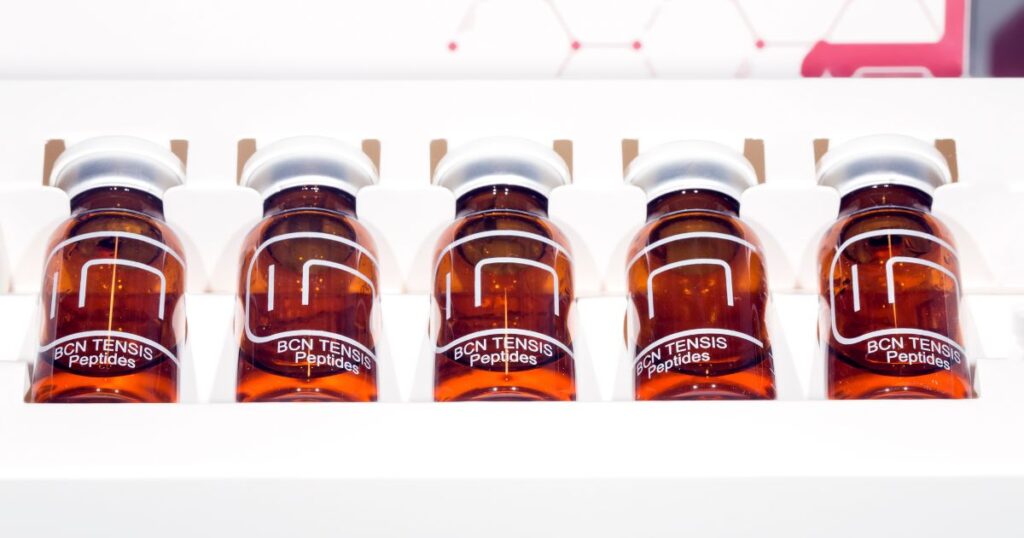Peptides
Difference Between Peptides and SARMs
In the world of fitness and health supplements, there has been a growing interest in compounds that can enhance performance, accelerate muscle growth, and aid in recovery. Among these compounds, two categories have stood out for their potential benefits and widespread attention: peptides and selective androgen receptor modulators (SARMs). Both peptides and SARMs have gained popularity in bodybuilding and athletic circles due to their ability to influence physical performance, body composition, and overall health. However, these two substances work in very different ways, each having its own set of characteristics, mechanisms, and benefits.
While both peptides and SARMs are often discussed in similar contexts—usually around muscle building, fat loss, and recovery—they are not interchangeable. Understanding the difference between peptides and SARMs is crucial for anyone considering incorporating these compounds into their health or fitness regimen. Both can provide benefits, but the way they work, their safety profiles, and their long-term effects differ significantly.
What Are Peptides?
Peptides are short chains of amino acids, which are the building blocks of proteins. In essence, peptides are smaller versions of proteins and are naturally found throughout the human body. Peptides serve as signaling molecules, meaning they can communicate with cells and direct specific biological processes, such as hormone production, tissue repair, and immune function. Because peptides can be synthetically produced and modified to mimic or enhance natural processes, they have become increasingly popular as therapeutic agents in various fields, including skincare, medicine, and sports performance.
In the context of fitness and muscle growth, peptides are often used to stimulate the release of growth hormone, which is a key factor in muscle repair, recovery, and fat loss. Peptides like growth hormone-releasing peptides (GHRP) and insulin-like growth factor-1 (IGF-1) have been studied for their ability to promote muscle growth, increase metabolism, and enhance tissue repair. Since these peptides work by stimulating the body’s own natural processes rather than directly altering hormonal levels, they are generally considered to be safer and more natural than many other performance-enhancing substances.
Peptides have gained significant traction not only for their muscle-building potential but also for their ability to promote healing and recovery. Many athletes use peptides to accelerate recovery from injuries, improve joint health, and maintain lean muscle mass during periods of intense training. Because peptides work on a cellular level, their effects tend to be more subtle and gradual compared to other compounds like anabolic steroids or SARMs, but their potential for promoting long-term health and fitness is substantial.
What Are SARMs?
SARMs, or selective androgen receptor modulators, are a class of compounds designed to mimic the effects of anabolic steroids without the severe side effects commonly associated with steroid use. SARMs work by selectively binding to androgen receptors in specific tissues, such as muscle and bone, without affecting other tissues like the liver, prostate, or heart. This selective action makes SARMs a more targeted and potentially safer alternative to traditional anabolic steroids, which can cause widespread hormonal disruption and a range of dangerous side effects.
The main appeal of SARMs lies in their ability to promote muscle growth and fat loss, much like anabolic steroids, but with fewer risks. Because SARMs specifically target muscle and bone tissues, they are thought to enhance muscle growth and improve bone density without the adverse effects on other organs. This has made them attractive not only to bodybuilders and athletes looking to improve their physical performance but also to medical researchers exploring SARMs as potential treatments for conditions like osteoporosis, muscle wasting, and age-related muscle loss.
Some of the most common SARMs include Ostarine (MK-2866), Ligandrol (LGD-4033), and Andarine (S4). Each of these compounds has been shown to have varying degrees of anabolic activity, with the ability to promote lean muscle mass, improve strength, and reduce body fat. While SARMs are generally considered less harmful than steroids, they are not without their risks. Since SARMs still interact with the body’s hormonal system, they can cause side effects like testosterone suppression, liver toxicity, and mood changes, especially when used in high doses or for extended periods.
How Peptides and SARMs Differ Mechanically
One of the main differences between peptides and SARMs lies in their mechanisms of action. Peptides work primarily by stimulating natural processes in the body, such as hormone production or cell signaling. For example, peptides that stimulate the release of growth hormone do so by influencing the pituitary gland to secrete more of this hormone, which then facilitates muscle growth, fat loss, and recovery. Because peptides are derived from naturally occurring substances in the body, they tend to work harmoniously with the body’s biological systems.
SARMs, on the other hand, work by directly binding to androgen receptors in muscle and bone tissues. Androgen receptors are responsible for mediating the effects of androgens—hormones like testosterone that play a significant role in muscle growth, bone density, and overall physical performance. SARMs are engineered to selectively activate these receptors, promoting an anabolic (muscle-building) response without triggering androgenic (hormone-related) side effects in other parts of the body. This makes SARMs a more potent option for building muscle and strength compared to peptides, but also increases the risk of hormonal imbalances and side effects.
Applications and Uses of Peptides and SARMs
While both peptides and SARMs are used in fitness and performance-enhancement settings, their applications can differ based on the specific needs of the individual.
Peptides are often chosen by individuals looking to improve overall health, recovery, and longevity. Athletes and bodybuilders may use peptides to stimulate growth hormone production, which in turn supports muscle recovery, fat loss, and improved sleep. Because peptides support the body’s natural functions, they are commonly used for long-term wellness strategies, including anti-aging treatments, wound healing, and injury rehabilitation. In sports, peptides have gained popularity as a means to improve endurance, support muscle repair, and reduce inflammation.
On the other hand, SARMs are often favored by those looking for more dramatic changes in muscle mass and strength in a shorter period. Bodybuilders who are preparing for competitions or those looking to break through plateaus may turn to SARMs to achieve a more immediate anabolic effect. SARMs are also used in clinical settings for medical purposes, such as treating muscle-wasting diseases and osteoporosis, but their use in bodybuilding circles has grown due to their ability to deliver quick results without the side effects of traditional steroids.
While peptides offer a more gradual and holistic approach to health and performance, SARMs are designed for those seeking rapid muscle gains and fat loss. This difference in application reflects the underlying differences in how these compounds affect the body.
Safety Profiles and Side Effects
Another major distinction between peptides and SARMs lies in their safety profiles. Peptides are generally regarded as safer and have fewer known side effects compared to SARMs. Since peptides mimic natural processes in the body, they are less likely to disrupt the hormonal balance or cause harmful effects. Common side effects of peptide use, when they occur, are typically mild and may include irritation at the injection site or temporary fluid retention. Because peptides promote natural hormone production, they do not suppress the body’s own production of hormones in the same way that SARMs or steroids might.
SARMs, however, come with a more complex risk profile. While they are considered safer than anabolic steroids, SARMs can still cause side effects, particularly with improper use or high dosages. One of the most significant risks associated with SARMs is testosterone suppression. Since SARMs interact with androgen receptors, they can trick the body into reducing its own production of testosterone. This can lead to symptoms of low testosterone, such as fatigue, mood swings, and reduced libido, especially when SARMs are used over a long period. Additionally, some SARMs have been linked to liver toxicity, cardiovascular issues, and potential hormonal imbalances.
Another important consideration is the regulatory status of these compounds. While peptides are widely available as supplements, especially in the wellness industry, SARMs are more heavily regulated due to their potency and potential for abuse. In many countries, SARMs are classified as research chemicals and are not approved for human consumption outside of clinical trials. This has raised concerns about the safety and quality of SARMs sold on the black market, where products may be mislabeled or contaminated.
Conclusion
Both peptides and SARMs offer unique benefits for individuals looking to improve their fitness, performance, and overall health. Peptides work by supporting the body’s natural processes, offering a safer and more gradual approach to muscle growth, recovery, and fat loss. SARMs, on the other hand, provide a more powerful anabolic effect by selectively binding to androgen receptors in muscle and bone tissues, leading to faster gains in muscle mass and strength.
The decision between using peptides or SARMs ultimately depends on the individual’s goals, risk tolerance, and long-term health considerations. While peptides offer a lower risk and more natural approach, SARMs may be more appealing to those seeking immediate and dramatic results. However, the potential side effects and regulatory challenges associated with SARMs should not be overlooked. Understanding the fundamental differences between these two compounds is key to making informed choices about their use in fitness and health regimens.

